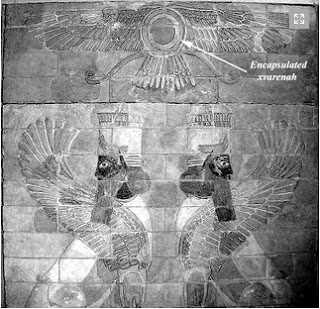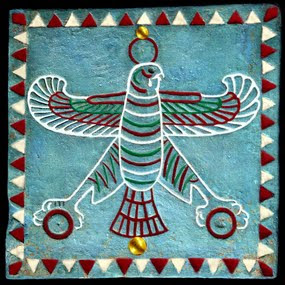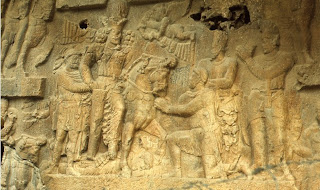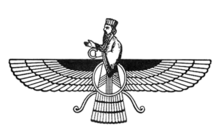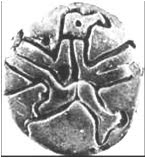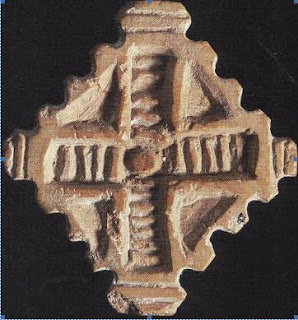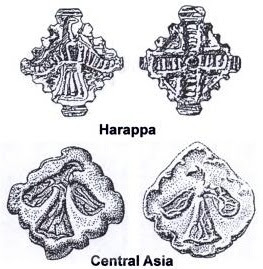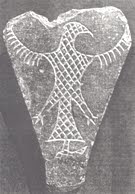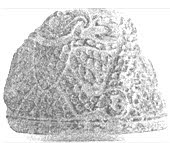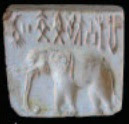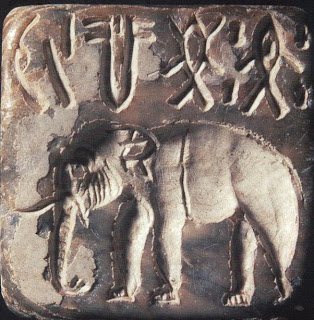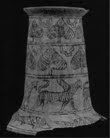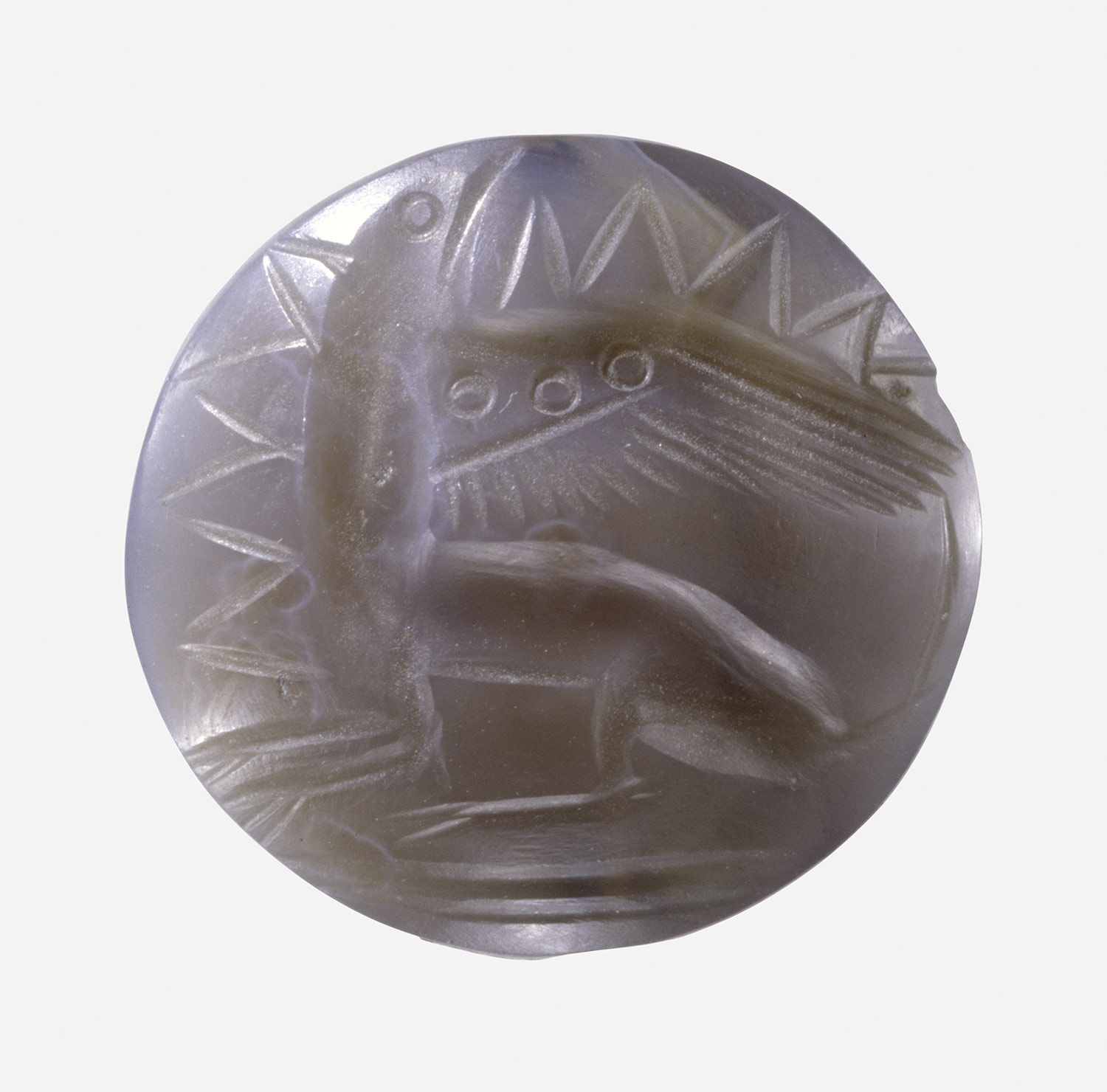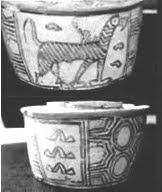About two dozen sealings and ten sealed bullae (some baked) have been discovered at Gonur and Togolok. I.S. Klotchkov suggests that signs on a potsherd of Gonur contain Elamite linear script. (Klotchkov, 1998, Signs on a potsherd from Gonur (on the question of the script used in Margiana), Ancient civilizations from Scythia to Siberia, 5(2): 165-176; cf. Klotchkov, IS, 1999, Glyptics of Margiana, Ancient civilizations from Scythia to Siberia, 6(2): 41-62.
Amulets and seals made of soft stone and pierced lengthwise often have a swastika engraved on one side. (Sarianidi, V. I., Die Kunst des Alten Afghanistan, Leipzig, 1986, Abb. 100; Fig. 1 after Sarianidi, V. I., Bactrian Centre of Ancient Art, Mesopotamia, 12 / 1977, Fig. 59 / 18; Fig. Of inter-locked snakes after Sarianidi, V. I., Seal- Amulets of the Murghab Style, in: Kohl, Ph. L., ed., The Bronze Age Civilization of Central Asia, New York, 1981,
Fig. 7.). Svastika is an Indus script hieroglyph.
The wings of the eagle are a dominant motif on some seals which find comparable glyptics related to Ahura Mazda.
Persepolis door jamb drawing (based on Curtis and Tallis, p. 76).
Sphinx guarding the xᵛarenah symbol, glazed bricks from Susa, Louvre Museum (photo A. Soudavar)
khvarnah is symbolised by the winged-sphere. Ahura Mazdā explains how the possession of the feather of a falcon (the bird vārənjina- {Bartholomae, 1904, col. 1411, s.v. vārən-gan-}, elsewhere vārə-gan- {ibid., col. 1412}) allows the pious Mazdean to counter-curse his opponents. "...even though in his avatars Verethragna takes the form of the wind, the ram, and the falcon, all associated one way or another with the khvarnah, he cannot claim solar radiance that is the main attribute of khvarnah and the quintessential symbol of Mithrā."Verethragna (vərəθraγna) is an Avestan language neuter noun literally meaning "smiting of resistance" (Gnoli, 1989:510; Boyce 1975:63). Representing this concept is the divinity Verethragna, who is the hypostasis of "victory", and "as a giver of victory Verethragna plainly enjoyed the greatest popularity of old" (Boyce, 1975:63)...Verethragna descends from an Indo-Iranian god known as *vrtra-g'han- (virtually PIE *wltro-gwhen-) "slayer of the blocker"-- Indra...Verethragna is the god of ‘Vrahran Fire’ and victory and the personification of aggressive triumph. ‘Vrahran Fire’ is the most sacred of all fires. It is a combination of 16 fires, most of which belong to those in the metalworking trades.
Falcon carrying the encapsulated xᵛarenah (pearls), glazed plaque from Persepolis. (Computer regeneration courtesy of Shahrokh Razmjou)
Symbol of Ahura Mazdā with added solar emblem of Šamaš, Bisotun. (Soudavar, 2003, fig. 85)
Apąm Napāt offering a dastār as symbol of farr and victory. Detail of Shapur I’s victory relief. Bišāpur (photo A. Soudavar). The hand-delivered ribbon was termed dastaar (victory-giver). Dastaar (dast, 'hand, victory') was synonymous with farr (a long ribbon tied as a head-band). A flying ring or 'winged-disk' indicated the presence of xᵛarənah -- central encapsulated element within the circle of the bird-like winged-disk. vareγna is a carrier of xᵛarənah. xᵛar is the sun. Darius qualified himself as Ariya, Ariya čiça -- Aryan and of Aryan radiance. The ribbon was a symbol of the Iranian xvarenah.
Bird Vareghna representing Xvarnah , royal glory and the worship of Ahura Mazda is aniconic. Glyptics relate to seated or kneeling deities on thrones, heroes in combat, serpents, winged lions, griffins, animals, birds, scorpions, snakes. About a bird depicted on BMAC seals, Sarianidi notes, asssociating the bird with Varaghna, the symbol of might and victory in Avesta: 'I suppose that this image was generated in the local Indo-Iranian milieu before Zarathustra.' (Sarianidi V. 1998,Myths of Ancient Bactria and Margiana on its Seals and Amulets. Moscow, p. 23) BMAC seals are distinctive indigenous to the Central Asian bronze age and have been found in the Indus civilization, on the Iranian plateau, at Susa and in the Gulf. Clearly, BMAC demonstrates contacts among people from Indus, Mesopotamia and people from Egypt to Aegean.
"Over most of human history there has been an equilibrium situation. In a given geographical area there would have been a number of political groups, of similar size and organization, with no one group having undue prestige over the others. Each would have spoken its own language or dialect. They would have constituted a long-term linguistic area, with the languages existing in a state of relative equilibrium."(Dixon, R. M. W., 1997. The Rise and Fall of Languages. Cambridge: Cambridge University Press, p. 3)
Sites: A, Mikhailovka; B, Petrovka; C, Arkhaim; D, Sintashta; E, Botai; F, Namazga; G, Gonur; H, Togolok; I, Dashly Oasis; J, Sapelli; K, Djarkutan; L, Hissar; M, Shahr-i-Sokhta; N, Sibri; O, Shahdad; P, Yahya; Q, Susa. Cultures: 1, Cucuteni (NWM)-Tripolye; 2, Pit Grave/Catacomb;3, Sintashta/Arkhaim; 4, Abashevo; 5, Afanasievo; 6, Andronovo; 7, Bactrian Margiana archaeological complex; 8, Indus; 9, Akkadian; 10, Hurrian; 11, Hittite (See CC Lamberg-Karlovsky,2002, Archaeology and Language. The Indo-Iranians, Current Anthropology, Vol. 43, No. 1, February 2002).
In this perspective of a linguistic area, is it reasonable to hypothesise that Indus language speakers were also present in sites on Iranian plateau, Baluchistan, Afghanistan and Indus-Sarasvati river valleys -- sites such as Susa, Shahdad, Yahya, Khurab, Sibri, Miri Qalat, Deh Morasi Ghundai, Nausharo, Gonur, Togolok, Djarkutan, Sapalli etc.? What linguistic area could explain the delineation of hieroglyphs of Gonur Tepe seals/seal impressions, using the rebus principle of depicting pictographs to denote similar sounding words?
The presence of Indus script inscriptions in Gonur Tepe can be explained using these hypotheses.
m1390Bt Text 2868 Pict-74: Bird in flight.m0451A,B Text3235 h166A,B Harappa Seal; Vats 1940, II: Pl. XCI.255.
Compartmented stamp seal with winged goddess on a dragon, late 3rd–early 2nd millennium B.C. Western Central Asia, Gonur-depe, Tomb 570. Silver. The National Museum of Turkmenistan Named After Saparmurat Turkmenbashi, Ashgabat. This seal depicts a female figure wearing a tufted full-length robe. This image is well known in the art of western Central Asia. However, here the female is shown with wings, suggesting that we are looking at a deity. This might relate the figure to the image of the Mesopotamian goddess Ishtar who is shown with outstretched wings from the Akkadian period onward. This female is shown with her face in profile looking to the right, and she sits sidesaddle on a scaly dragon facing backward. The dragon has its tail curling up toward its rider. The monster's tail and front paws cross the frame of the seal, and its mouth is open in a snarl. On this seal the deity wears a full-length tufted robe. The knob rising out of the seal was presumably used for holding the seal while making impressions.
A compartment seal from Gonur with the 'eagle' motif.
Eagle incised on a ceremonial axe made of chlorite. Tepe Yahya. (After Fig. 9.6 in Philip H. Kohl, 2001, opcit.)
Nippur vessel with combatant snake and eagle motif. Istanbul Museum. The design is raised above the base; the vessel of chlorite was found in a mixed Ur III context at Nippur in southern Mesopotamia.
Indus tyle seal from Gonur Tepe in Central Asia comparable to an 'eagle seal' from Harappa (after Masson 1988, Vats 1941)
Gonur 1 in the Murghab delta; dark brown stone (Sarianidi 1981 b: 232-233, Fig. 7,8); eagle engraved, entwined snakes engraves.
abru = wing (Akkadian/Assyrian) Rebus: abāru = lead; antimony (annaku is most unlikely to be lead rather than tin).(cf. CAD A (II): 126; AHw 49) (Akkadian/Assyrian). Grapheme: abaru = enclose, surround; aburru = enclosure (Akkadian/Assyrian) abaru = be strong, powerful; strength, power (Akkadian/Assyrian)
sen:gel gidi = the male of the Indian king-vulture, ologyps calvus (Santali.lex.)sen:gel = fire; sen:gel kut.ra = a spark of fire, a burning bit of wood; sen:gel ku_n.d. = a heavy fire (Mundari) gitil bali = grains of magnetic iron resembling sand (Santali)sen:gel gidi rebus: sen:gel gitil = (furnace) fire for meteoric iron fragments.
pajhaṛ ‘eagle’ (Santali) pajhar. = the Indian tawny , the Indian black eagle, the Indian crested hawk; eagle, buru pajhar., the hill-eagle, aquila imperialis; hako sat.i pajhaṛ = a fish-eating eagle (also called dak pajhar.); huru pajhaṛ = the imperial eagle (Santali .lex.) panji-il = a certain feather in each wing of a vulture (Mundari .lex.) [See the hieroglyph of an eagle ligatured to a tiger on a Nal pot.
Limestone wall plaque from Susa (After J. Boese, 1971, Almesopotamische Weihplatten: Eine sumerische Denkmalsgattung des 3, Jahrtausends v. Chr., Berlin/New York: de Gruyter,: Taf: XXIV.21]. This plaque shows, on the lower register a person plunging a dagger at a tiger which seems to have subdued a bull.
kol ‘tiger’ (Santali)] kol 'tiger' (Santali) Rebus: kol is pancaloha, alloy of five metals (Tamil); kollan ‘smith’ (Tamil). Ligatured tiger to reinforce tiger as hieroglyph
A woman's face and headdress ligatured to a tiger: kul 'tiger' (Santali); kōlu id. (Te.) kōlupuli = Bengal tiger (Te.)kōla = woman (Nahali) [The ligature of a woman to a tiger is a phonetic determinant; the scribe clearly conveys that the gloss represented is kōla] Pk. kolhuya -- , kulha -- m. ʻ jackal ʼ < *kōḍhu -- ; H.kolhā, °lā m. ʻ jackal ʼ, adj. ʻ crafty ʼ; G. kohlũ, °lũ n. ʻ jackal ʼ, M. kolhā, °lā m. krōṣṭŕ̊ ʻ crying ʼ BhP., m. ʻ jackal ʼ RV. = krṓṣṭu -- m. Pāṇ. [√kruś] Pa. koṭṭhu -- , °uka -- and kotthu -- , °uka -- m. ʻ jackal ʼ, Pk. koṭṭhu -- m.; Si. koṭa ʻ jackal ʼ, koṭiya ʻ leopard ʼ GS 42 (CDIAL 3615). कोल्हा [ kōlhā ] कोल्हें [ kōlhēṃ ] A jackal (Marathi) Rebus: Ta. kol working in iron, blacksmith; kollaṉ blacksmith. Ma. kollan blacksmith, artificer. Ko. kole·l smithy, temple in Kota village. To. kwala·l Kota smithy. Ka. kolime, kolume, kulame, kulime, kulume, kulme fire-pit, furnace; (Bell.; U.P.U.) konimi blacksmith; (Gowda) kolla id. Koḍ. kollë blacksmith. Te. kolimi furnace. Go. (SR.) kollusānā to mend implements; (Ph.) kolstānā, kulsānā to forge; (Tr.) kōlstānā to repair (of ploughshares); (SR.) kolmi smithy (Voc. 948). Kuwi (F.) kolhali to forge (DEDR 2133) கொல்² kol Working in iron; கொற்றொழில். Blacksmith; கொல்லன். (Tamil) pajhaṛ = to sprout from a root; pagra = a cutting of sugar-cane used for planting (Santali .lex.) Elephant hieroglyphCylinder seal impression: Rhinoceros, elephant, lizard.Tell Asmar (Eshnunna), Iraq. IM 14674; glazed steatite; Frankfort, 1955, No. 642; Collon, 1987, Fig. 610.
Indus 'elephant' seal from Gonur Tepe(compiled from images supplied by Maurizio Tosi, Gregory L Possehl and Viktor Sarianidi). Posted in Expedition, Vol. 49, No. 1, 2007
Text of Indus inscription on Mohenjodaro copper tablet m527 (obverse: elephant in front of trough)
m527 Mohenjodaro copper tablet.
ibha ‘elephant’ (Skt.); rebus: ib ‘iron’ (Santali) karibha ‘elephant’ (Skt.); rebus: karb ‘iron’ (Ka.)
Two semantic clusters point to glosses meaning ‘iron’. One cluster relates to karba and cognates in Indian linguistic area. The second cluster relates to ib and cognates in Inddian linguistic area. Both are relatable to homonyms (and related graphemes) of elephant. The rebus words for elephant are: karin, karabha and ibha
An allograph is ficus religiosa: karibha -- m. ʻ Ficus religiosa (?) [Semantics of ficus religiosa may be relatable to homonyms used to denote both the sacred tree and rebus gloss: loa, ficus (Santali); loh ‘metal’ (Skt.)]
karba 'iron' (Ka.)(DEDR 1278) as in ajirda karba 'iron' (Ka.) kari, karu 'black' (Ma.)(DEDR 1278) karbura 'gold' (Ka.) karbon 'black gold, iron' (Ka.) kabbiṇa 'iron' (Ka.) karum pon 'iron' (Ta.); kabin 'iron' (Ko.)(DEDR 1278)
Ib 'iron' (Santali) [cf. Toda gloss below: ib ‘needle’.] Ta. Irumpu iron, instrument, weapon. a. irumpu,irimpu iron. Ko. ibid. To. Ib needle. Koḍ. Irïmbï iron. Te. Inumu id. Kol. (Kin.) inum (pl. inmul)iron, sword. Kui (Friend-Pereira) rumba vaḍi ironstone (for vaḍi, see 5285). (DEDR 486)
Mohenjo-daro. Elephant glyph shown on two copper tablets. karabha ‘young elephant; karin elephant; ibha id. (Skt.)
Griffin, Baluchistan (Provenance unknown); ficus leaves, tiger, with a wing, ligatured to an eagle. The ligature on the Nal pot ca 2800 BCE (Baluchisan: first settlement in southeastern Baluchistan was in the 4th millennium BCE) is extraordinary: an eagle's head is ligatured to the body of a tiger. In BMAC area, the 'eagle' is a recurrent motif on seals. Ute Franke-Vogt: "Different pottery styles link this area also to central and northern Balochistan, and after about 2900/2800 BCE to southern Sindh where, at this time, the Indus Civilization took shape. The Nal pottery with its particular geometric and figurative patterns painted in blue, yellow, red and turquoise after firing is among the earliest and most dominanstyles in the south."
Lentoid seal with a griffin, ca. 1450–1400 B.C.;Late Minoan II Minoan; Greece, Crete Agate; H. 1 1/16 in. (2.7 cm), W. 1 1/16 (2.7 cm), Diam. ½ in. (1.2 cm) It is engraved with an image of a crouching griffin, a powerful mythical creature with the head and wings of a bird and the body of a lion. "This Minoan seal is lentoid, which describes its shape when viewed in profile. It is engraved with an image of a crouching griffin, a powerful mythical creature with the head and wings of a bird and the body of a lion. Before literacy became widespread, such seals served for identification or to mark ownership. While the first seals may have been made of organic materials that have perished, the earliest surviving examples are of clay. Later, in the Early Minoan period, various easily worked materials such as ivory, bone, shell, and soft stones, including serpentine and steatite, were adopted. In the Middle and Late Minoan periods, harder stones such as rock crystal, hematite, jasper, agate, and chalcedony gained favor. The general dating of seals is correlated with that of the palaces that were the centers of culture on Crete. The apogee of Minoan gem engraving occurred during the time of the second palaces, between about 1600 and 1450 B.C., when semiprecious stones such as agate were engraved with consummately rendered figural subjects, particularly animals." http://www.metmuseum.org
Eric Olijdam, 2008, A possible central Asian origin for the seal-impressed jar from the 'Temple Tower' at Failaka, in: E. Olijdam & RH Spoor (eds.), Intercultural relations between south and southwest Asia, Studies in commemoration of ECL During Caspers (1934-1996), BAR International Series 1826 (2008): 268-287.
Eric Olijdam, 2008, A possible central Asian origin for the seal-impressed jar from the 'Temple Tower' at Failaka (2008)
"AHURA, designation of a type of deity inherited by Zoroastrianism from the prehistoric Indo-Iranian religion. In the Rig Veda, asura denotes the “older gods,” such as the “Father Asura” (10.124.3), Varuṇa, and Mitra, who originally ruled over the primeval undifferentiated Chaos. The emergence of the dualistic cosmos was a process of polarization in which some of the asuras, such as Agni (Fire), Soma, Varuṇa, and Mitra, went over to the “younger gods,” the devas. The other asuras were driven away from the earth and remained as exiles in the nether world. The Rig Veda still preserves a terminological distinction between “asuras that have become devas” (devāˊv ásurā 8.25.4, cf. 7.65.2) and “asuras that are non-devas” (ásurā adevāˊḥ 8.96.9). In the later texts the term asura is limited to the latter group. Varuṇa was incorporated into the ordered world as the lord of the subterranean world, including the cosmic waters on which the earth rests, and of the cosmic law (Ṛta); but his character remained ambiguous. According to the later Mahābhārata, his exiled brothers were either his servants in the nether world or his prisoners. In the Rig Veda he was, although dreaded, at the same time worshiped as the god who initiated his devotees as mystical seers (7.88); i.e., he made them médhira “wise” like himself (7.87.4). This wisdom, “(revealed) insight into the cosmic order” (medhāˊ ṛtásya), was the exclusive privilege of seers (8.6.10). Iranian mazdā was equivalent to médhira...In the later Avesta traces of a pre-Zoroastrian mythology are preserved in ahuraδata “created by the Ahura” (L. Renou and E. Benveniste, Vrtra et Vrθragna, Paris, 1934, pp. 42-09), in ahura as an epithet of Mithra and the mythological figure Apam Napāt “grandson of the waters,” and in ahurānī “wife of Ahura” as an epithet of the waters and the name of a deity of the water. Cf. Varuṇa as the lord of the waters. In the archaic metrical formula Miθra Ahura bərəzanta “Mithra and Ahura, the exalted ones” (Yt. 10.113, etc.), which corresponds to Vedic Mitrā-Váruṇā, Ahura is clearly the pre-Zoroastrian counterpart of Varuṇa. The question as to what was his ancient Indo-Iranian name can not be answered, because taboo substitutes can have arisen at any time (Nyberg, Irans forntida Religioner, Stockholm, 1937, p. 108; F. B. J. Kuiper, “The Bliss of Aša,” IIJ 8, 1964-65, p. 109, n. 68). Cf. Prácetas in the Yajur Veda, and anāmaka “nameless” and Daθuš “Creator” in the Old Persian and the Zoroastrian calendars respectively." Source: Encyclopaedia Iranica. AHURA
designation of a type of deity inherited by Zoroastrianism from the prehistoric Indo-Iranian religion.
Vrtra et Vrθragna, Étude de Mythologie Indo-Iranienne. Par E. Benveniste et L. Renou. Cahiers de la Société Asiatique III. Paris: Imprimerie Nationale, 1934.
H. W. B. (1935).
Bulletin of the School of Oriental and African Studies,
Volume 7, Issue 04, February 1935 pp 975-976
http://journals.cambridge.org/abstract_S0041977X00086456
Bulletin of the School of Oriental and African Studies,
Volume 7, Issue 04, February 1935 pp 975-976
http://journals.cambridge.org/abstract_S0041977X00086456
"The neuter noun verethragna is related to Avestan verethra, 'obstacle' and verethragnan, 'victorious'. (Gnoli, Gherardo, 1989, "Bahram in old and middle Iranian texts", Encyclopaedia Iranica, 3, New York: Routledge & Kegan Paul, p. 510.)...Indar is the god of warfare, courage and bravery and also the god of thunderstorm and ugliness. Indar often rides an elephant. His epithet Verethragna appears as a god of victory. Verethragna is the god of 'Vrahran Fire' and victory and the personification of aggressive triumph. 'Vrahran Fire' is the most sacred of all fires. It is a combination of 16 fires, most of which belong to those in the metalworking trades. Another epithet of Verethragna in Sanskrit Vishnu or Avestan language Bahram is the god of the planets and victory. He is the assistant of Sraosa or Sarasvati a member of the Amesha Spentas, and helps her when Sraosa raises the soul of the deceased from their body. He punishes the evil done by man and demon. Verethragna appears in many shapes: bear, bird of prey, bull, camel, youth, warrior with a golden sword, wind, etc. His appearance as a bird and bear were especially popular. The twentieth day of the month is dedicated to him. His eternal opponent is Asha vahishta, the guardian of fire and all other luminaries. The name and, to some extent, the deity has correspondences in Armenian Vahagn and Vram, Sogdian Wshn, Parthian Wryhrm, and Kushan Orlagno. While the figure of Verethragna is highly complex, parallels have also been drawn between it and (variously) Vedic Indra, Puranic Vishnu, Manichean Adamas, Chaldean/Babylonian Nergal, Egyptian Horus, Hellenes Ares and Heracles...The identification of Verethragna as a boar in Yasht 14 led Ilya Gershevitch to identify Daamooish Upamana -- a boar in the Avestan hymn to Mithra -- to be an alter-ego of Verethragna (Gershevitch, 1959: 166-169; pro Gnoli, 1989: 511; contra Boyce, 1975: 83, n. 416)...one theory (Benveniste/Renou, 1934) proposed that in Indo-Iranian times there existed a dragon-slaying warrior god Indra and that Avestan Verethragna derived from that divine figure. The arguments against this theory are manifold: For one, there is no hint of Verethragna (or any other Zoroastrian divinity) having dragon-slaying functions. In the Avest it is the hero warrior-priest Thraetaona who battles the serpent Azi Dahaaka (which, for the virtue of 'Azi' being cognate with Sanskrit 'Ahi', snake, is -- by proponets of the theory -- associated with Vedic Vritra). Moreoever, in the Vedas, the epithet 'hero' (Sura) is itself almost exclusively reserved for Indra, while in the Avesta it is applied to Thraetaona and other non-divine figures. The term "victorious" too is not restricted to Verethragna, but is also a property of a number of other figures, both divine and mortal, including Thraetaona. Then, while in the Vedas it is Indra who discovers Soma, in the Avesta it is humans who first press Haoma and Thraetaona is attributed with being the "inventor of medicine". In the Vedas, Indra strikes with vajra, but in the Avesta vazra is Mithra's weapon. Finally, and from a point of basic doctrine far more important than any of the other arguments, Indra is a daeva, precisely that class of divinity that Zoroaster exhorts his followers to reject. Indeed, Indra is explicitly named as one of the six evil demons in Vendidad 10.9 – directly opposing the Amesha Spenta Asha Vahishta, with whom Verethragna is associated.
Attempts to resolve these objections led to the development of another theory, in which, in addition to the pre-historical divinity of victory, there was also a dragon-slaying hero *Indra. Then, while the Iranians retained the figures independently of one another, the Indians conflated the two (leaving an echo in the character of Trita Aptya).
This theory too had its problems, in particular the fact that Indra was already evidently a divine figure, and not a man, in the Mittani treaties, where he appears in the company of Mitra and Varuna. That again raises more questions since the treaties echo the Rig Veda's invocation of all three as protectors of contract, again, not a property associated with Verethragna.
However, as Benveniste and Renou demonstrated, many of the objections to the first theory could be negated if the evidence were reviewed in light of the fact that the principal feature of Verethragna was not to slay noxious creatures but to overcome obstacles (verethra), in particular to unblock the flow of apas, the waters, the holiest of the elements. (Benveniste & Renou, 1934:182). Paul Thieme agreed with this principal feature, but clarified that while the wealth of archaic elements in the Bahram Yasht clearly point to the pre-Zoroastrian era, the interpretation of proper names is "highly conjectural", and "in no case do we get a decisive argument against their Indo-Aryan or old Indic character" (Thieme, 1960:302). Adopting "the exact linguistic and exegetic analysis" of Benveniste and Renou, Thieme concludes "Proto-Aryan *Indra has assumed the functions of a Proto-Aryan god *Vrtraghna." Noting that Vrtrahan is the name of Indra only in the later Sanskrit texts (but not in the Rig Veda), Thieme adds "there is no valid justification for supposing that the Proto-Aryan adjective *vrtraghan was specifically connected with *Indra or any other particular god." (Thieme 1960:312-313)."
Bibliography
Benveniste, Emile & Renou, Louis (1934), Vrtra et Vrθragna, Paris: Imprimerie Nationale
Boyce, Mary (1975), History of Zoroastrianism, Vol. I, The early period, Leiden: Brill, ISBN 90-04-10474-7
Boyce, Mary (1982), History of Zoroastrianism, Vol. II, Under the Achamenians, Leiden: Brill, ISBN 90-04-06506-7
Duchesne-Guillemin, Jacques (1973), Religion of ancient Iran, Bombay: Tata Press
Dumezil, Georges (1970), The destiny of the warrior, Chicago: University of Chicago Press, ISBN 0-226-16970-7
Gnoli, Gherardo (1989), "Bahram in old and middle Iranian texts", Encyclopaedia Iranica, 3, New York: Routledge & Kegan Paul, pp. 510–513
Lommel, Herman (1939), Der arische Kriegsgott, Frankfurt/Main: Klostermann
Thieme, Paul (1960), "The 'Aryan' Gods of the Mitanni Treaties", Journal of the American Oriental Society 80 (4): 301–317
West, Edward William (1880), Marvels of Zoroastrianism: The Bahman Yasht In Müller, Friedrich Max (ed.). SBE, Vol. 5. Oxford: OUP.
Zaehner, Richard Charles (1955), Zurvan, a Zoroastrian dilemma, Oxford: Clarendon, ISBN 0-8196-0280-9 (1972 Biblo-Moser ed).
Source: http://www.artrocker.com/rrpedia/Verethragna
Vahrām or Bahrām (modern Persian, var: Behrām; middle Persian: Warahran) is the Zoroastrian concept of "victory over resistance" and, as the hypostasis of victory, is one of the principal figures in the Zoroastrian pantheon of yazatas. Bahram's alter ego in the Avesta is Dāmōiš Upamana, and in the Bahram Yasht is addressed as Verethragna (Vɘrɘθraγna), meaning 'smiting of resistance', related to Avestan verethra, 'obstacle' and verethragnan, 'victorious'. (Encyclopedia: Bahram in old and middle Iranian texts. Gnoli, Gherardo. Encyclopaedia Iranica. 2002. New York. Mazda Pub. 510-513.)
On the Zoroastrian Temple Cult of Fire by Mary Boyce
Source: Journal of the American Oriental Society, Vol. 95, No. 3 (Jul. - Sep., 1975), pp. 454-
465
zoroastriantemplecultoffiremaryboyce

